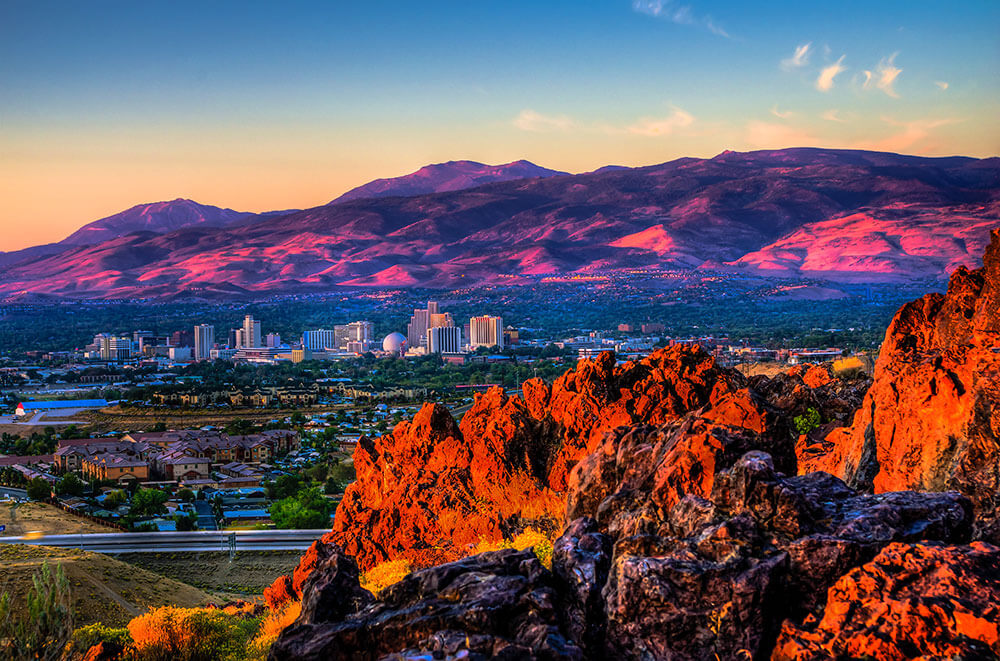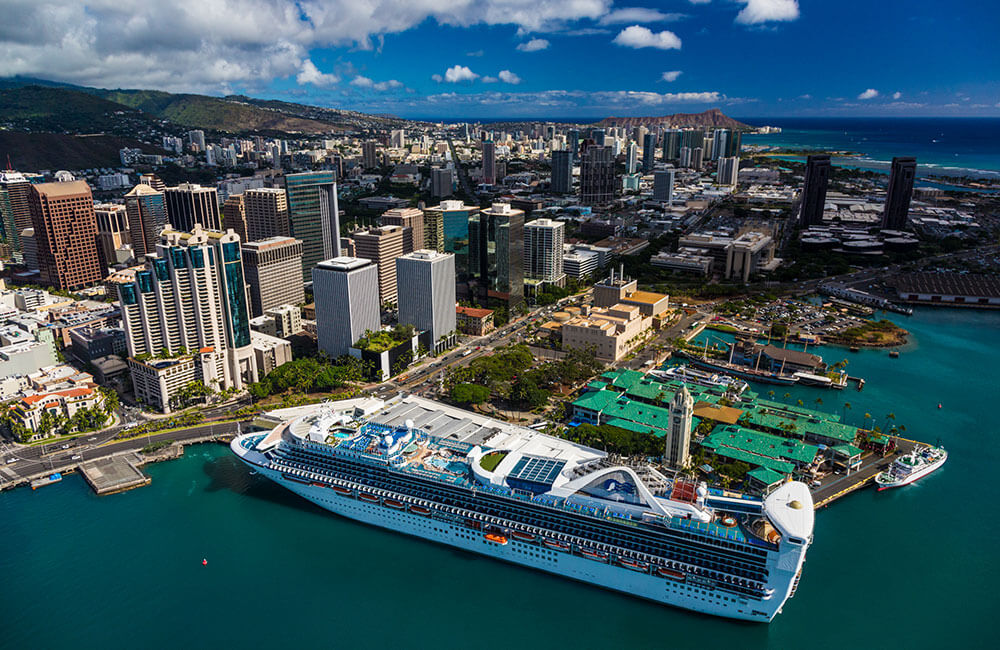
Reno is sixth on the latest “America’s Best Small Cities” list, earning points for its convention center and offbeat attractions. (Courtesy RenoTahoe)
A sun-drenched casino town with vivid nightlife, quirky attractions, and a spacious convention center is a slam-dunk destination for many event planners. But we aren’t talking Vegas. Reno, Vegas’ little sister, 440 miles to the northwest, ranks sixth on Resonance Consultancy’s recent list of “America’s Best Small Cities,” earning points for assets that Resonance says are separating it from the pack — like its convention center (which “ranks No. 2, just behind Atlantic City”) and offbeat attractions like the new Urban Air Adventure Park trampoline emporium.
Vegas is still a powerhouse. It ranks seventh among big cities, or those with more than a million residents, on Resonance’s big-city list, which was once again topped by New York City. But today, as big cities get costlier and more crowded and visitors demand more immersive experiences, second-tier cities are more frequently becoming first-choice destinations for events and leisure travel.
Resonance, which considers a city small if its metropolitan area population is between 200,000 and 1 million, compiles rankings in six key categories. Its “product” category is where cities are judged on criteria that frequently matter most to event planners, including university rankings, air connectivity, and convention center size. But it weighs 23 factors, including standard of living, diversity, safety, and dining.
“We really tried,” said Resonance’s president and CEO, Chris Fair, “to take a holistic approach to benchmarking cities.” Fair, whose company specializes in tourism, real estate, and economic development consulting, spoke with Convene about this year’s rankings and the state of cities.

Colorado Springs made the “best” list, edging into the Top 10 after ranking 11th last year. (Courtesy visitcos.com)
The “Best Cities” list is very ambitious, serving many masters, so to speak. How do you describe the list and what it sets out to do?
Rather than just looking at livability, looking at tourism appeal, or looking at factors related to investment attraction, we tried to identify a range of factors that had influenced all of those things. … The goal here was trying to provide a more comprehensive perspective. Especially when you’re using a label such as “best cities” — well, best cities for what? What we’re looking at is cities that really balance livability, opportunity, and desirability.
When you look at the top small cities, what we call second-tier cities, what trends are you seeing?
The rankings are a little bit more fluid with the smaller cities in that the difference in being in fifth place and 15th place can be very slight. And there are many more cities of that size, so there’s more competition for the same number of top spots. … I think also, in terms of trends, small cities are investing heavily. Whether that’s in parks, transportation, arts and cultural districts, small cities are really realizing the power of placemaking and quality of life [as ways] to influence their future prosperity. So there’s a lot going on in the small city space — more so than ever before.
One small city new to the Top 10 this year is Colorado Springs. What put it there?
Colorado Springs was actually just outside the Top 10 at No. 11 last year. It moved from 45th to 21st in our “place” category (which measures such things as weather and safety) and from 11th to 4th in our “promotion” category (which measures a city’s ability to tell its story, such as on social media), which helped propel it into the Top 10.
Honolulu, as it did last year, topped the small cities list. What makes it so compelling — besides the ocean and its wildlife?
Well it certainly has a lot of great natural features. It also happens to be one of those cities that’s just shy of a million people. So within our rankings its obvious advantage is that it is the largest of the small cities. Aside from that, it’s got the natural features that you spoke of, in term of beaches, parks, mountains, access to an incredible array of outdoor experiences. But it also has tremendous culture and character in terms of the culinary experiences that the city offers. I think that’s probably one thing people don’t necessarily think about, Honolulu — food — but there’s a real burgeoning food scene.
Are you seeing emerging food scenes beyond Honolulu?
I think culinary and food are everywhere. Great restaurants and great culinary used to be the provenance of large cities, but now you can find great restaurants in Greenville, and Knoxville, and Asheville, and cities throughout the Southeast or the West. So probably one of the more significant trends or changes is the growth in the quality and diversity of culinary in many small cities across America.

Honolulu is the largest of the small cities on Resonance’s list — a factor that helps lock in its top spot. (Tor Johnson/Hawaii Tourism Authority)
You probably get asked this all the time, but are cities already talking about the visitor of the future? Have millennials and Gen Xers already changed cities’ perspectives?
I think cities are still reacting to the changes and preferences of travelers, the single biggest example of that being Airbnb. Here’s an entire platform that didn’t exist, or barely existed, a decade ago. And today, because of home sharing, we have tourists that are moving around and experiencing parts of cities that tourists never went to before. So that’s a real significant change. And that desire of visitors, not only millennial visitors, but visitors of all types to live like a local in a city is really changing the way cities are consumed as destinations. I think cities still have a lot of work to do to catch up.
What do you see on the horizon in the home-sharing front?
There are some new and innovative models. There are companies like Sonder that are interesting, where they are basically professionalizing the practice of home-sharing by leasing out floors in an apartment building, and turning them all into short-term apartment rentals that are licensed and legal within the city.
What else are you seeing in terms of cities and the experiences they offer?
Our research is proving out that many of the factors that attract tourists are the very same factors that attract talent. So cities are now looking at this more holistically than maybe they have in the past. A lot of the amenities, services, and things they might have thought were important to quality of life for their residents are also important in attracting visitors, the High Line in New York being a great example of that. The High Line was never designed to be a tourist attraction; it was designed to enhance quality of life for people in that part of the city. But it attracts millions of visitors a year and is used far more by visitors than it is by local residents. And then the opposite to that is that many of the factors that we know are important in attracting tourists, are also important in attracting talent. So what were two very separate silos, are becoming increasingly aligned and I think those cities that recognize that and move on it have an advantage in realizing it’s not either/or, it’s both.
Last year you spoke with Convene about what’s around and outside “the box,” as in convention centers, being increasingly more important in determining where people want to have events. Is there a city that you see doing a really good job of going after business events?
I’d say Nashville and Austin are two that have done a good job of marrying a good product, in terms of the convention center itself, with significant new quality hotel inventory, all surrounded by a vibrant urban experience — it’s a winning combination for large and small cities alike.
What else can we learn from Resonance’s lists?
Today everybody wants to be an Austin or Nashville, but 15 to 20 years ago that wasn’t the case. So I think it’s interesting to look at our list today and at cities like El Paso, or Chattanooga, or Colorado Springs that really maybe aren’t on people’s radar yet. We look at our list as a bit of a prognostication as to what the next “it” city could be.
Cristi Kempf is executive editor at Convene.
Top 10 Small Cities for Product
(fewer than 1 million people)
- Honolulu, Hawaii
- Albuquerque, New Mexico
- Reno, Nevada
- Myrtle Beach, South Carolina
- Omaha, Nebraska
- Tulsa, Oklahoma
- Charleston, South Carolina
- Durham, North Carolina
- Asheville, North Carolina
- Greenville, South Carolina
Top 10 Small Cities for Product
(fewer than 1 million people)
- Honolulu, Hawaii
- Albuquerque, New Mexico
- Reno, Nevada
- Myrtle Beach, South Carolina
- Omaha, Nebraska
- Tulsa, Oklahoma
- Charleston, South Carolina
- Durham, North Carolina
- Asheville, North Carolina
- Greenville, South Carolina
